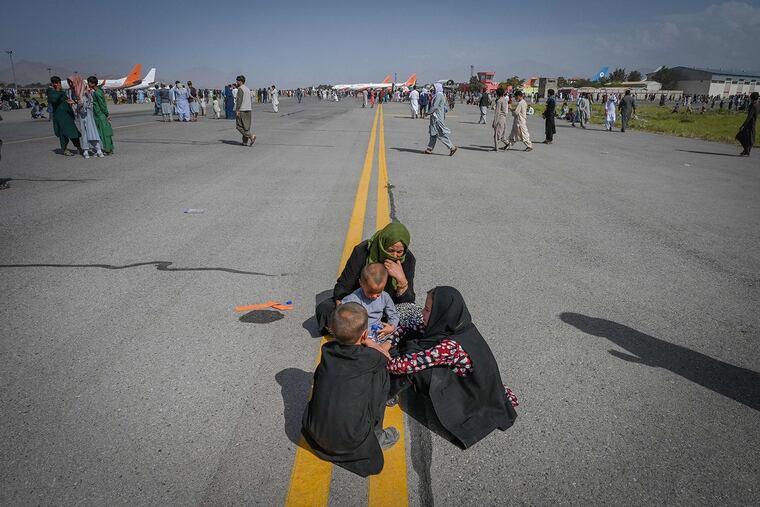What you need to know about the chaotic U.S. departure from Afghanistan | Trudy Rubin
Answers to questions readers have asked about whether we had to leave Kabul and why the exit plans went so wrong.

I’m getting frantic emails from Afghan friends who can’t make it to Kabul airport before the U.S. evacuation ends.
They include U.S. Green Card holders, journalists, and Afghans who worked for the U.S. government along with former translators for the U.S. military. Some are already being targeted by name by the Taliban, none are likely to be rescued, many may be killed.
President Biden has held firm to the Aug. 31 date for final exit of all U.S. troops. The evacuation of Afghans will probably stop by this weekend, abandoning not only some Americans but tens of thousands of Afghans who were promised special visas.
I’ve been besieged by questions from readers wondering whether our “longest war” was doomed to end so badly. Here are some answers, along with a link to a live virtual event that I did on Monday, answering more.
» READ MORE: President Biden, get our Afghan allies out on evacuation planes I Trudy Rubin
Was President Biden bound by former President Trump’s February 2020 “peace” deal with the Taliban to pull all troops out by Aug. 31?
No. Trump’s deal was a surrender document that gave everything to the Taliban, including the release of 5,000 Taliban prisoners and a withdrawal date for U.S. troops of May 31, 2021. In return, the U.S. got virtually nothing — no cease-fire, no substantive Taliban negotiations with the Afghan government, only a “promise” by the Taliban to cease dealings with al-Qaeda supporters that has already been broken. Biden extended the withdrawal date by three months, but was under no obligation to stick by that deal.
Why then did Biden decide on a total U.S. troop pullout by Aug. 31?
Biden had wanted to end the Afghan “forever war” since 2009, when he was overruled by President Barack Obama. Understandably, he wanted to clear the decks to deal with COVID-19 and other domestic problems, along with China and Russia. However, there were only 2,500 U.S. troops left in Afghanistan — backed up by 7,500 NATO forces and several thousand contractors — who were taking almost no casualties, but were providing crucial air support, intelligence, and maintenance to Afghan forces. I’ve argued their presence was no longer a “forever war” but rather an affordable insurance policy to prevent a Taliban takeover or a resurgence of al-Qaeda along with other terrorist groups. Similar to the insurance policy of nearly 30,000 U.S. troops in South Korea to prevent North Korean military pressure. The Taliban could not have taken Afghan cities, especially Kabul, if U.S. air support remained.
Why did the Afghan army collapse so fast?
From the time of Trump’s surrender deal, Afghan military morale was plummeting, and Biden’s Aug. 31 deadline sent it through the floor. Moreover, corruption in Kabul kept soldiers short on food, supplies, and salaries. And, directly across the Afghan border, Pakistan’s military and ISI intelligence agency — which may have managed the Taliban’s final campaign — gave the group money, supplies, training, strategic guidance, and safe havens for regrouping. With the U.S. exit in sight, soldiers and politicians judged the game was over and fled or made survival deals with the Taliban.
Could the evacuation have been handled better? Or — as the Biden team has claimed — was this the greatest evacuation in history?
The Pentagon had warned the Biden team regularly that any mass evacuation of Afghan translators and others should best be done before giving up Bagram Airfield, because Kabul airport would be besieged by civilians. The White House thought it would have “a decent interval” of time before the Afghan government fell, and could evacuate slowly. Many experts saw the likelihood of swift government collapse; unclear why Biden didn’t. As for “greatest evacuation”— the military has done a great pickup job under awful circumstances, but the description hardly fits. The Berlin airlift (which brought food in, not people out) lasted a year, and we got more than 120,000 South Vietnamese people out by plane, helicopter, and ship before the final U.S. exit in 1975. This chaotic evacuation — in which many flights left half empty because Afghans couldn’t get through the airport gates — means we leave some Americans, and thousands of Afghans who worked alongside us, behind.
Would Trump have done better at an evacuation?
Definitely not. The White House antipathy to refugees, and gutting of State Department staff, had already blocked the evacuation of most Afghan translators. And Trump had demonstrated his disdain for local allies, as when he pulled U.S. forces back from the Turkish-Syrian border overnight in December 2019, with no prior notice to our Syrian Kurdish military allies or to U.S. special forces based there. The Turkish military then killed scores of our allies and drove out tens of thousands of Syrian Kurdish civilians.
» READ MORE: White House must authorize evacuation of Afghans who helped us before it is too late I Trudy Rubin
Could Biden have extended the Aug. 31 deadline?
The Taliban said no, and the White House feared an ISIS-K terrorist attack on Afghan civilians or U.S. at the airport. However, I still can’t grasp why CIA Director William Burns wasn’t able to negotiate a deal when he met with Taliban leaders at the airport this week, swapping humanitarian aid for a delayed exit. Presumably we’ll find out.
How can you help Afghans who do make it out?
You can start here: How to help Afghan refugees: Where you can volunteer, donate, and more in Philadelphia. You can also watch a live virtual event I did with deputy opinion editor Erica Palan.